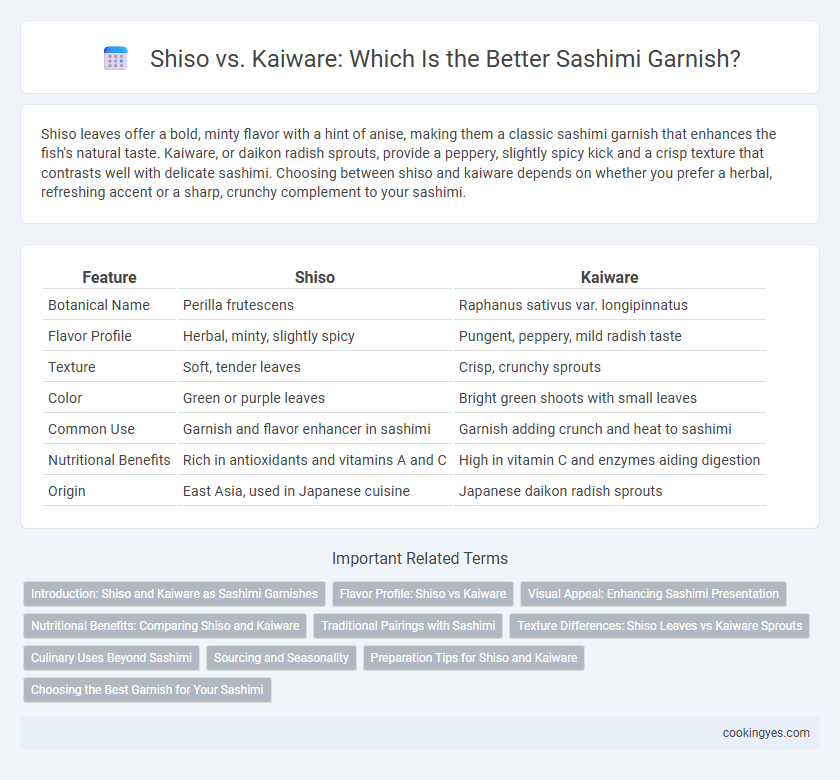Shiso leaves offer a bold, minty flavor with a hint of anise, making them a classic sashimi garnish that enhances the fish's natural taste. Kaiware, or daikon radish sprouts, provide a peppery, slightly spicy kick and a crisp texture that contrasts well with delicate sashimi. Choosing between shiso and kaiware depends on whether you prefer a herbal, refreshing accent or a sharp, crunchy complement to your sashimi.
Table of Comparison
| Feature | Shiso | Kaiware |
|---|---|---|
| Botanical Name | Perilla frutescens | Raphanus sativus var. longipinnatus |
| Flavor Profile | Herbal, minty, slightly spicy | Pungent, peppery, mild radish taste |
| Texture | Soft, tender leaves | Crisp, crunchy sprouts |
| Color | Green or purple leaves | Bright green shoots with small leaves |
| Common Use | Garnish and flavor enhancer in sashimi | Garnish adding crunch and heat to sashimi |
| Nutritional Benefits | Rich in antioxidants and vitamins A and C | High in vitamin C and enzymes aiding digestion |
| Origin | East Asia, used in Japanese cuisine | Japanese daikon radish sprouts |
Introduction: Shiso and Kaiware as Sashimi Garnishes
Shiso leaves provide a refreshing, aromatic flavor with hints of mint and basil, enhancing sashimi with their vibrant green color and delicate texture. Kaiware, young daikon radish sprouts, offer a crisp, peppery bite that contrasts well with the soft, rich texture of sashimi, adding visual appeal with their slender, bright green stems. Both garnishes play essential roles in Japanese cuisine, balancing taste and presentation for an authentic sashimi experience.
Flavor Profile: Shiso vs Kaiware
Shiso leaves offer a complex flavor profile with hints of mint, basil, and anise, providing a refreshing and aromatic complement to sashimi. Kaiware sprouts bring a sharp, peppery bite with subtle mustard undertones, adding a spicy contrast that enhances the delicate fish. Choosing between Shiso and Kaiware depends on whether you prefer herbal and cooling notes or a bold, pungent accent to elevate sashimi.
Visual Appeal: Enhancing Sashimi Presentation
Shiso leaves offer vibrant green hues and serrated edges, creating a bold contrast that visually accentuates sashimi slices. Kaiware sprouts bring delicate, thin stems and small leaves, adding a subtle, elegant texture that softens the plate's overall appearance. Both garnishes enhance sashimi presentation by balancing color intensity and form, elevating the dish's aesthetic and sensory appeal.
Nutritional Benefits: Comparing Shiso and Kaiware
Shiso leaves are rich in antioxidants, vitamins A and C, and essential minerals like calcium and iron, supporting immune function and bone health when used as sashimi garnishes. Kaiware sprouts provide a high concentration of vitamin C, folate, and glucosinolates, compounds known for their anti-inflammatory and cancer-fighting properties. Both garnishes enhance sashimi not only with unique flavors but also by contributing distinct nutritional benefits that complement the dish's overall health profile.
Traditional Pairings with Sashimi
Shiso leaves offer a peppery, minty flavor that complements the delicate taste of sashimi, traditionally enhancing the umami profile of fish like salmon and tuna. Kaiware sprouts provide a sharp, slightly spicy bite that contrasts well with richer sashimi cuts such as fatty tuna (otoro). Both garnishes are deeply rooted in Japanese culinary tradition, serving not only as flavor enhancers but also as visual accents that elevate the presentation of sashimi plates.
Texture Differences: Shiso Leaves vs Kaiware Sprouts
Shiso leaves provide a tender yet slightly coarse texture that enhances sashimi with a delicate, aromatic chew. Kaiware sprouts offer a crisp, crunchy bite that contrasts sharply with the smoothness of raw fish, adding a refreshing snap. The choice between shiso and kaiware significantly impacts the textural balance of sashimi, complementing different flavor profiles through their distinct mouthfeel.
Culinary Uses Beyond Sashimi
Shiso leaves offer a distinct, aromatic flavor with hints of mint and basil, making them perfect for wrapping sushi rolls, enhancing salads, or infusing dressings and sauces. Kaiware sprouts provide a sharp, peppery bite that complements not only sashimi but also sandwiches, rice bowls, and garnishes for grilled meats or tofu dishes. Both shiso and kaiware elevate dishes with their unique textures and flavors, extending their use well beyond traditional sashimi presentations.
Sourcing and Seasonality
Shiso leaves, often sourced from Japanese farms, thrive in temperate climates and are typically available year-round, ensuring a fresh, aromatic garnish for sashimi dishes. Kaiware, young daikon radish sprouts, are commonly cultivated indoors or in controlled environments, allowing for continuous availability but tend to peak during cooler seasons in late fall to early spring. Both garnishes require careful sourcing to maintain freshness and vibrant flavor profiles that enhance the sashimi experience.
Preparation Tips for Shiso and Kaiware
Shiso leaves require careful washing and gentle drying to preserve their delicate texture and flavor before slicing into thin strips or whole leaves to complement sashimi. Kaiware radish sprouts should be thoroughly rinsed and drained to remove any soil residue, then trimmed at the root end to ensure freshness and a crisp bite alongside raw fish. Both garnishes offer distinct visual appeal and flavor profiles, enhancing sashimi presentation with shiso's herbal notes and kaiware's peppery spice.
Choosing the Best Garnish for Your Sashimi
Shiso leaves provide a distinctive, aromatic flavor with hints of mint and basil, enhancing the delicate taste of sashimi while adding vibrant green color. Kaiware, or daikon radish sprouts, offer a sharp, peppery bite and crunchy texture that contrast well with the soft sashimi slices. Selecting between shiso and kaiware depends on whether you prefer a fragrant herbal garnish or a bold, spicy accent to complement your sashimi experience.
Shiso vs Kaiware for sashimi garnishes Infographic

 cookingyes.com
cookingyes.com